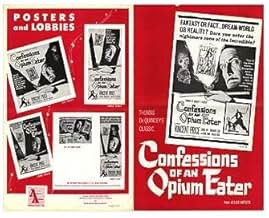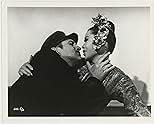Confessioni di un fumatore d'oppio
Aggiungi una trama nella tua linguaIn 19th-century San Francisco's Chinatown, American adventurer Gilbert De Quincey saves slave girls owned by the Chinese Tong factions.In 19th-century San Francisco's Chinatown, American adventurer Gilbert De Quincey saves slave girls owned by the Chinese Tong factions.In 19th-century San Francisco's Chinatown, American adventurer Gilbert De Quincey saves slave girls owned by the Chinese Tong factions.
- Lotus
- (as June Kim)
- Lo Tsen
- (as Caroline Kido)
- First Dancing Girl
- (as Joanne Miya)
- Auctionieer
- (as John Mamo)
Recensioni in evidenza
Some years ago I had read Thomas DeQuincey's literary classic "Confessions Of An English Opium Eater" (for the record, Dario Argento's SUSPIRIA {1977} derives its title from the author's "Suspiria De Profundis") – along with Aleister Crowley's "Diary Of A Drug Fiend" (another such book I acquired but which I have yet to go through is Aldous Huxley's "The Doors Of Perception") – while preparing to embark on my third screenplay but its semi-autobiographical fantasia nature has, so far, largely proved hard to pin down! Having said that, despite the fact that Vincent Price's central character in the movie was named Gilbert DeQuincey and it does feature a series of hallucinatory sequences, the film under review is no adaptation of the book. For one thing, it is set in San Francisco against the original's London and, as if to emphasize that difference, it was distributed also under the alternative monikers of SOULS FOR SALE (which is the title sported by the thankfully good-looking TV print I watched that does justice to Eugene Lourie''s remarkable production design - after an earlier one I had come by proved very fuzzy!) and EVILS OF CHINATOWN. For what it is worth, the film is said to have inspired John Carpenter's BIG TROUBLE IN LITTLE CHINA (1986), a guilty pleasure from my childhood days!
Actually, this is the first example I have watched from Zugsmith's tawdry directorial efforts and, by all accounts, it is the only one worth seeing. Conversely, his credits as producer were pretty impressive and versatile: Douglas Sirk's WRITTEN ON THE WIND (1956) and THE TARNISHED ANGELS (1957); a clutch of Jack Arnold films, including his best i.e. THE INCREDIBLE SHRINKING MAN (1957); and, finally, Orson Welles' TOUCH OF EVIL (1958) which, given its drug-addiction subplot, is the most pertinent to CONFESSIONS. Discriminating viewers might well find this one of the most inept things they had ever witnessed but, for those able to accept its uniqueness, the sheer oddity on display exerts an undeniable fascination. Right from the opening sequence showing a horse galloping on a deserted beach, followed by a curiously silent pirate crew manhandling their captive female cargo around (sometimes being literally thrown overboard into a descending net and falling, comically speeded-up, into place and in unison on a waiting barge!) and, when a scuffle erupts on the beach between Tong factions, the horse makes a sudden reappearance to save one of the girls (who later has an active part in the narrative) by pushing her assailant off of a cliff! The 'abduction of women for pleasure' theme links this to Price's later vehicle, the Harry Alan Towers production HOUSE OF A THOUSAND DOLLS (1967; where the star's role was more ambiguous yet less adventurous than here), a viewing of which actually preceded this one!
The hallucination sequences are truly weird here, with a proliferation of predictably nightmarish images and slow-motion chases that are suddenly speeded-up, like Price's fall from a rooftop; incidentally, it is a rare sight to have Vincent Price as the action hero but, then, the entire film feels like it did not belong in the early 1960s! The underground slave trading sequence is one of the most striking in the film, even if this includes a succession of protracted dance routines that are meant to show off the attractive qualities of the 'merchandise' on display to the gathering of prospective buyers! Price, who is forever spouting poetically-defiant lines at his captors (even while embarrassingly hanging off-the-ground on a meat-hook!), finds an improbable ally in a spirited female midget who eventually gets a knife in the back just as they are about to make their escape down a manhole. Curiously enough for a movie of which he is the intermittent narrator, Price himself is presumed dead at the very end as he and the villainess (the actress playing her bears the unfortunately appropriate name of Linda Ho!) are whisked away by the flowing underground currents.
An adventurer (Vincent Price) in 19th century San Francisco becomes involved with Tong wars, slave auctions of Chinese girls and opium dens.
This is one of the most bizarre films I have ever seen. Even more jaw dropping that it got made in 1962. It is exploitation madness at it's best. Price however brings his great talent and class to make this a cut above other strange films made in the 1960s. All the Asian roles are played by real Asians such as busy character actors like Richard Loo and Philip Ahn. Linda Ho plays an evil "Mata Hari" type. She is deliciously nasty and smolderingly sexy in this part, probably the best role she ever had in her short film career. When Price settles down with a pipe in an opium den, there is a incredible druggy fight sequence all done in slow motion, it has to be seen to be believed. Another highlight is a wisecracking female Chinese dwarf (Alicia Li) who provides some wickedly funny quips. It ends with an auction scene where girls are sold for opium. They do some suggestive dances which most have seemed scandalous at the time. Price fans and anyone interested in something weird should seek this out.
Albert Zugsmith, better known as the producer of Orson Welles' "Touch of Evil", produced and directed "Opium Eater", a black and white b-grader hastily dismissed by reviewers. It has genuine merit to those who like offbeat cinema. Although it uses Thomas De Quincey's 1821 book title, (actually called "Confessions of an English Opium Eater") it conjures up its own story of deception and murder. Price as Gilbert De Quincey, who also narrates the film, suggests he is an ancestor. "Opium Eater" actually has more in common with the Fu Manchu mysteries or the yellow peril pulps popular in the 1930s. Add to this its fortune cookie dialogue and ramblings about dreams, reality, death and destiny and you have one very strange movie indeed. There is no doubt "Opium Eater" is bizarre, but it is also literate and genuinely mysterious.
Albert Glasser's spooky soundtrack is one of the films great strengths. His eerie electronic score endows it with an ambience of unease and dislocation. In one scene, after Price awakens from his opium-induced nightmare, axe-wielding henchmen chase him across rooftops. Here the music drops right off the soundtrack and we are left with only an unnerving silence. Zugsmith's direction is clumsy at times but many intriguing moments make up for this, including his creative use of slow motion and the nightmare montage in the joss house. This drug scene must have been quite controversial in 1962 and I wonder if it was snipped from certain prints or caused the film to be banned in some areas.
The love/hate relationship between De Quincey and Ruby Low suggests their fate is predetermined and leads to a quite unexpected, but oddly satisfying outcome.
It's a flawed film, but remains a curious, haunting experience deserving of a cult following. >
Nominally based on Thomas De Quincy's CONFESSIONS OF AN ENGLISH OPIUM EATER, it seems a mildly incoherent, sloppily composed movie. On the other hand, there is the implication that this is all an opium dream, which would go a ways towards explaining the lack of sense. Given that the producer-director, Albert Zugsmith, was a hard-working man who had produced movies like Orson Welles' TOUCH OF EVIL and directed SAPPHO DARLIng, I'll come down in the middle. I think he intended this to be an opium dream, but given the script by Robert Hill, the remnants of the Production Code, and his own less than stellar talents, it's not a great success. Still, it provides a chance to see a lot of Studio Era actors like ichard Loo, Phillip Ahn, and Victor Sen Yung.
Lo sapevi?
- QuizIndirectly led to the creation of the famed East West Players. Many of the Asian actors, including a young James Hong, were incensed after the only roles they were offered were "opium dope people and the prostitutes and so forth." After a petition to producer Albert Zugsmith fell on deaf ears, Hong co-founded the East West Players to give Asian-American actors more meaningful, non-stereotypical roles.
- BlooperThis film takes place in the 19th century, as stated, and seen in the townspeople's dress. But in the beach scene, a Thompson machine gun is used; this wasn't available until after 1918.
- Citazioni
Gilbert De Quincey: [narration] When the dreams of the dark, idle, monstrous phenomenae move forever forward... wild, barbarous, capricious into the great yawning darkness... to be fixed for centuries in secret rooms. De Quincey, the artist? De Quincey, the pagan priest, to be worshipped, to be sacrificed. What is a dream and what is reality? Sometimes a man's life can be a nightmare; other times, cannot a nightmare be life? And the voices that I heard, were they the voices of some strange imitation of men in some strange, writhing jungle of my imagination? Was this opium or was it reality? Was I dead? Or I was I only beginning to live?
- ConnessioniEdited from Voodoo Woman (1957)
I più visti
- How long is Confessions of an Opium Eater?Powered by Alexa
Dettagli
- Data di uscita
- Paese di origine
- Lingua
- Celebre anche come
- Confessions of an Opium Eater
- Luoghi delle riprese
- Azienda produttrice
- Vedi altri crediti dell’azienda su IMDbPro
- Tempo di esecuzione1 ora 25 minuti
- Colore
- Proporzioni
- 1.37 : 1
Contribuisci a questa pagina































